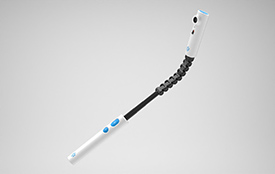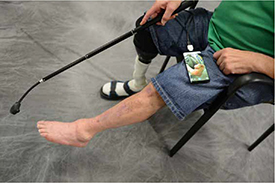A skin monitor for hard-to-view body locations
September 1, 2020
Original Article From: VA Department of Research & Development
Researchers at the Minneapolis VA Health Care System have developed a device called Habit Camera that helps people monitor their skin in parts of the body that are difficult to see, such as their backsides and the bottoms of their feet.
The Habit Camera system, originally called SkinSyte, is similar to a selfie-stick, but its camera is separated from the monitor so people using it can get a better view of their skin. Patients can zoom in on an area of concern, take a photo, and send it to their dermatologist or other health care provider for advice.
Habit Camera is particularly valuable to Veterans and others with spinal cord injuries (SCIs) and those who have developed a condition called diabetic neuropathy. People with those issues aren’t aware when pressure injuries, or sores, develop on areas of their body they cannot see. It’s hard to get a good view of those areas with a mirror, which is what most people currently use. Finding sores is especially challenging for those whose mobility is limited, like SCI patients, and for those who have decreased vision.

Image courtesy of Habit Camera
Individuals with skin cancer also need to frequently inspect posterior surfaces of their skin for signs of reoccurrence, and people who often visit the woods need to check the back of their knees and their necks for ticks. Discovering problems earlier through Habit Camera can improve treatment outcomes and reduce the need for interventions like amputations, hospitalizations, and surgeries.
Habit Camera consists of a high-definition camera, just larger than a quarter, mounted on an extended and bendable handle. The handle’s flexible gooseneck component allows the user to view otherwise difficult to access areas. Attaching the camera to a cellphone or tablet wirelessly gives patients the ability to see a live video stream as they are screening or to take a high definition still photograph that can be compared to previous images or sent to caregivers.
The Habit Camera will be marketed and sold to the public by a company led by Derek Herrera, a former Marine special operations officer and experienced entrepreneur. Herrera, who uses a wheelchair for mobility, was medically retired in 2014 after being injured during combat operations in Afghanistan.
Principal investigator: Dr. Christine Olney, Minneapolis VA Health Care System
Selected publications:
VA research highlight: Skin screening device for early detection of pressure injury (SkinSyte)
Wand-mounted camera magnification of skin for self-monitoring and screening, TechLink
UMN and VA researchers develop adaptive technologies to help Veterans, University of Minnesota Press Release, June 27, 2019

